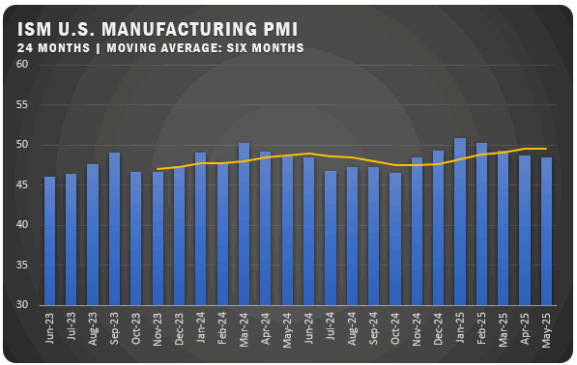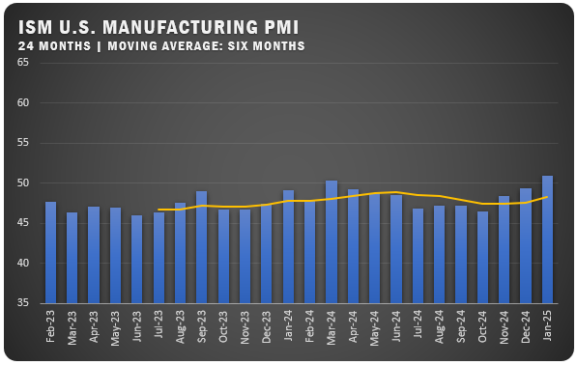U.S. Manufacturing Activity Slows Further in July
Declines in employment and supplier deliveries drive deeper contraction; tariff concerns continue to weigh on sentiment
U.S. manufacturing conditions deteriorated in July, marking the fifth consecutive month of contraction, according to the latest Manufacturing ISM® Report On Business. After a short-lived rebound earlier in the year, the sector remains under pressure from policy uncertainty, shifting global supply chains, and cautious hiring.
The Manufacturing PMI® fell to 48.0 percent, dropping 1 point from June’s 49.0 percent. While the broader U.S. economy continued its expansion streak to 63 months (excluding the brief dip in April 2020), the manufacturing sector saw renewed weakness driven by softer demand and slower deliveries.
The New Orders Index posted its sixth straight month of contraction but improved slightly to 47.1 percent. Backlogs also showed signs of stabilization, rising 2.5 points to 46.8 percent. Meanwhile, the Production Index climbed to 51.4 percent, marking a second month of growth, though manufacturers remain cautious in workforce planning.
Labor conditions worsened, with the Employment Index falling to 43.4 percent—a 1.6 percentage point drop from June—highlighting continued headcount reductions. According to panelists, most firms are still in workforce management mode rather than hiring, despite modest production gains.
On the supply side, delivery performance improved. The Supplier Deliveries Index fell to 49.3 percent after seven consecutive months in expansion territory, signaling faster turnaround times as demand cooled and logistics bottlenecks eased. Inventories dipped to 48.9 percent, reflecting more strategic stock management as firms adjust to shifting conditions.
Price pressures remained elevated but softened slightly, with the Prices Index decreasing to 64.8 percent. The Imports Index rose modestly to 47.6 percent, though it remained in contraction, while New Export Orders slipped again to 46.1 percent, continuing a trend of subdued foreign demand.
Overall, July’s data show an increasingly uneven manufacturing landscape. A significant 79 percent of the sector’s GDP was in contraction, up from 46 percent in June, with 31 percent of that strongly contracting (PMI at or below 45 percent). None of the six largest manufacturing industries reported growth in July, a sharp contrast to the previous month, when four posted expansion.
COMMODITIES
Up in Price: Aluminum (20); Aluminum Products; Brass Products; Copper; Copper Products; Corrugated Boxes (5); Electrical Components (6); Electronic Components (6); Fabricated Metal Components; Freight; Polypropylene; Steel (6); Steel — Stainless (5); Steel Products (5); and Wire Products.
Down in Price: Corn; Natural Gas; Ocean Freight; and Soybean Meal.
In Short Supply: Electrical Components, Electronic Components (5); and Rare Earth Magnets.
Note: The number of consecutive months the commodity is listed is indicated after each item.
U.S. SECTOR REPORT
ISM Growth Sectors (7): Apparel, Leather & Allied Products; Plastics & Rubber Products; Nonmetallic Mineral Products; Textile Mills; Miscellaneous Manufacturing; Furniture & Related Products; and Primary Metals.
ISM Contraction Sectors (10): Printing & Related Support Activities; Paper Products; Chemical Products; Machinery; Wood Products; Fabricated Metal Products; Computer & Electronic Products; Transportation Equipment; Electrical Equipment, Appliances & Components; and Food, Beverage & Tobacco Products.

JULY ISM REPORT COMMENTS
Computer & Electronic Products: “Fairly flat quarter over quarter, but with us being in the safety and security sector (and with U.S. Customs and Border Protection as a customer), the recent bill that passed should result in an increase in business in the coming months.”
Chemical Products: “Sales continue at unprecedented growth, driven by data-center construction. Customers and the sales team continue to demand lower pricing, which drives down gross margins in face of input price increases, primarily from aluminum imports.”
Apparel, Leather & Allied Products: “These tariff wars are beginning to wear us out. It’s been very difficult to forecast what we will pay in duties and calculate any cost savings we’ve had this year. Also, tariffs have disrupted our customs import bond. There is zero clarity about the future, and it’s been a difficult few months trying to figure out where everything is going to land and the impact on our business. So far, tremendous and unexpected costs have been incurred.”
Machinery: “Currently, higher interest rates still depress the construction industry for new construction projects. Tariff policies are uncertain, which slows down (1) our investment in new projects, (2) component sourcing for new products, (3) blanket orders and (4) replenishment of large inventory quantities. Instead, we’re working to shift suppliers to lower political risk countries or develop domestic sources. We are impacted by the higher tariffs on costs of raw materials and components both sourced domestically and from overseas, and we expect expenses will be higher in the third and fourth quarters as we consume the inventory received with new and higher tariffs or update costs from domestic sources in the second quarter.”
Fabricated Metal Products: “Sales softening more than usual during the summer. Negotiations with non-U.S. manufacturers are strained as we are reluctant to issue POs for deliveries three or more months into the future with prices that include current tariffs.”
Miscellaneous Manufacturing: “In the health-care world we continue with ‘business as normal,’ but we are increasingly searching and assessing geopolitical risk mitigation options.”
Electrical Equipment, Appliances & Components: “Tariffs are causing complete uncertainty around sourcing strategies. A sit-and-wait game for now.”
Nonmetallic Mineral Products: “Sales are about on par with 2024, but nowhere near budget forecast. Tariff concerns seem to be growing as the year progresses.”
Furniture & Related Products: “Business is steady, with solid bookings and backlog. Still uncertainty about tariffs and associated inflation.”
Primary Metals: “Energy capacity, specifically in the grid operated by PJM Interconnection, continues to be one of the major concerns for business continuity and growth in this region. The procurement of power and rising natural gas prices in this region due to past green energy policies, coupled with future projected allocations for artificial intelligence data centers, adds additional stress to the PJM system.”
Transportation Equipment: “Cautiously stable. Tariff impacts are still being monitored. Some increases have been implemented while monitoring other products.”
GLOBAL PMI NOTES

Eurozone: Eurozone manufacturing moved closer to stabilization in July, with the PMI ticking up to 49.8—its best showing since mid-2022. While output continued to grow modestly and job losses slowed, new orders declined again and confidence edged down, with Ireland and several southern economies leading growth.

Canada: Canada’s manufacturing sector remained under pressure in July, as the PMI rose slightly to 46.1 but continued to reflect persistent weakness driven by tariffs from the U.S. and domestic countermeasures. New orders and output contracted again, staffing cuts deepened, and firms remained cautious amid ongoing policy volatility despite easing input inflation.

China: China’s manufacturing activity slipped back into contraction in July, with the PMI falling to 49.5 amid a sharper drop in export demand and sluggish new orders. Output and employment declined, while rising raw material costs pushed input prices higher, but competitive pressures forced selling prices lower and kept optimism muted.

France: France’s manufacturing PMI held steady at 48.2 in July, reflecting ongoing softness in both domestic and export demand. New orders dropped at the sharpest rate since January, while production eased more moderately and business confidence fell to a five-month low.

Germany: Germany’s PMI was revised to 49.1 in July, its highest level in nearly three years, suggesting easing contraction despite continued weak demand. Input costs dropped further, producers cut prices for the third straight month, and optimism stayed positive though slightly softer than June’s peak.

India: India’s factory activity remained robust in July, as the PMI hit 59.1 — its highest mark since March 2024 — driven by surging new orders and strong output. Hiring continued, though at a slower pace, and while cost pressures intensified, output charges rose only slightly; sentiment remained upbeat despite slipping to a three-year low.

Italy: Italy’s manufacturing sector edged closer to recovery in July, with the PMI rising to 49.8—its strongest reading since March 2024. While staffing levels fell again, production and orders showed less decline, and both cost and selling prices increased for the first time in three months amid renewed business optimism.

Mexico: Mexico’s PMI climbed to 49.1 in July, indicating a softer contraction and the mildest downturn in six months. Output and employment fell at a slower pace, while cost pressures mounted and firms remained cautious despite improving sentiment.

United Kingdom: UK manufacturing conditions improved modestly in July, with the PMI rising to 48—the shallowest contraction since January—thanks to gains in consumer and intermediate goods. However, export challenges, persistent domestic weakness, and higher labor costs continued to weigh on orders and drive job cuts across the sector.
Sources: S&P Global, Trading Economics and Institute for Supply Management, PMI (Purchasing Manager Index), Report On Business.
Learn more about ISM at ismworld.org.





